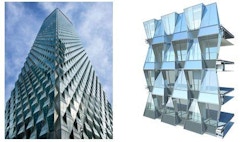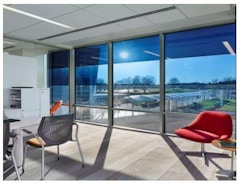
169 results
-
 Ever-increasing performance requirements in the latest version of the energy codes are compelling project teams to consider the thermal performance…
Ever-increasing performance requirements in the latest version of the energy codes are compelling project teams to consider the thermal performance… -

Data-Driven Shading Systems
- Paper by Simon Schleicher, Luis Santos, Luisa Caldas,
Analyzing the energy performance of complex building envelopes, determining the need for sun protection, and assessing the effectiveness of shading… -
Unitized Cavity Wall Design and Implementation
- Paper by Dan Bettenhausen, Ph.D., Director of Mechanical Engineering
Double Skin Facades (DSF), constructed from individual aluminum framed curtain wall assemblies, provide a means of achieving acoustic and thermal… -

Thermal Performance of Closed Cavity Facades
- Paper by Andrea Zani · Carmelo Guido Galante · Lisa Rammig
Closed cavity facades (CCF), a configuration of Double Skin Facade (DSF), consists of a double-glazed unit on the inner layer and single glazing on
-

Vintage Vinyl
- Paper by Michael S. Plewacki,
Mid-century through 1980’s buildings with lock-strip or “zipper-gasket” glazing systems are an ever present part of the urban landscape in many… -

Highly Efficient Façades with Innovative Shading and Light Control
- Paper by Klaus Reuschle, Project Director Robert Matthew Noblett, Partner Michelle Siu-Ching Lee, Roman Schieber, Associate Director ppa.
The Science and Engineering Complex (SEC) on the Allston Campus is the largest new building at Harvard University in recent decades with a footprint… -

Modelling Perimeter Heating Demand
- Paper by Jonathan Graham, Sustainability Analyst Geoffrey Turnbull, OAA, MRAIC, LEED AP, CPHD, Director of Innovation David Constable OAA, LEED AP, CPHD, Principal Mike Reimer P.Eng, LEED AP, Principal Joshua Vanwyck, CPHD, CEO
Thermal discomfort can occur in perimeter zones due to radiant heat loss from the occupant to a poorly insulated exterior wall. It is valuable for… -

Steel As A Curtain Wall Framing Material
- Paper by Charles Knickerbocker
This paper will explore steel forming methods other than cold drawn or hot rolled processes, and how they allow steel to be utilized as the primary
-
Recent Adaptive Textile Façade Systems
- Paper by Lucio Blandini, Director, Full Professor Moon-Young Jeong, Doctoral Researcher Michael Voigt, Doctoral Researcher, IKTD, University of Stuttgart Jonathan Lopez, Doctoral Researcher Hannah Schürmann, Doctoral Researcher Arina Cazan, Research Assistant Hannah Raisch, Student Daniel Roth, Head of Research Group Methodical Product Development, IKTD, University of Stuttgart Maria Matheou, Junior Professor
Adaptive facade systems are a promising approach to achieve a dynamic response to varying weather conditions and user demands. The interdisciplinary… -
Structural Skin
- Paper by John Neary
Many prominent, recent buildings feature forms suggesting structural surface while their enclosures are really non-load-bearing curtain wall. At the
-
Origami-Inspired Facade Design
- Paper by Joshua Schultz, Ph.D, P.E., LEED AP, ENV SP · Neil Katz, AIA
To paraphrase Robert le Ricolias, the art of the structure is where to put the folds. Using that inspiration, fundamental concepts from origami,
-

DC Water Headquarters Case Study
- Paper by Sven Shockey, Leland Curtis, David Fersh,
Facades must be responsive to a myriad of qualities and influences ranging from urban impact and aesthetic character to numerous performance… -

Managing Constraints
- Paper by Vincent IP, LEED AP BD+C, vip@nbbj.com
On a commercial high-rise tower project located in Hong Kong, the design team was challenged to make a facade that would beneficial to tenants with a… -
Thermal Comfort Assessment of Multi-Zone Electrochromic Window
- Paper by Ahoo Malekafzali, Ph.D.
Access to natural daylight and connection to the outdoor environment is one of the key elements of contemporary architecture. This design concept is
-

Contextual Envelopes
- Paper by Zoltan Neville
Aesthetic and technical capabilities of facade design have become seemingly endless as building technologies progress. While the capacity to address
-

U-Factor Matters in Hot Climates
- Paper by Helen Sanders, PhD
It is commonly thought that fenestration U-factor is not a key determinant in the performance of facades in hot climates, and generally the focus of
-
Spandrel Thermal Simulation Techniques
- Paper by Ivan Lee · Edlyn Garcia La Torre · Shahima Rahmatipour
Glazed wall systems, such as curtain walls and window walls, are one of the most commonly used façade systems in modern buildings in North America.
-

Condensation Study of Windows
- Paper by Ajla Aksamija, Professor and Chair Suncica Milosevic, PhD Student Helen Sanders, General Manager Alexandra Blakeslee, Innovation & Projects
This paper discusses a simulation study of different window systems, where heat transfer simulations were performed to investigate thermal… -
Sustainable Façades
- Paper by Dr. Thomas Henriksen, Jean-Marc Moulin Norsk, Dr. Jacopo Montali,
Transposing innovation from government funded research to commercially viable solutions becomes ever more important when combined with the urgent… -

Infinite Panel System
- Paper by Mike Ryan, Director of Product Development Facades Division Brian Stern, Regional Energy Director Michael Adams, Senior Energy Analyst
Today, building facades are expected to do much more than merely provide shelter, which is driving the need for higher performing envelope solutions.…

